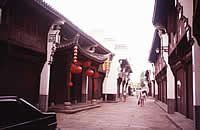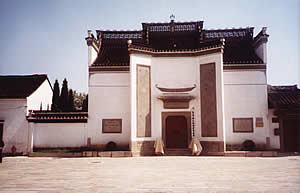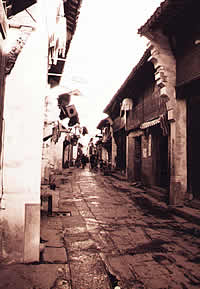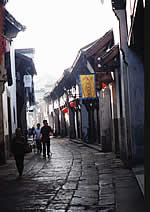| An ancient street in Gaochun |
| http://www.sina.com.cn 2003/11/18 17:22 中国周刊 |
Photos by Puyang Kangjing In the southwest corner of East China Jiangsu Province, Gaochun County lies in the southern outskirts of the provincial capital Nanjing, just a one and a half hour ride to downtown Nanjing. The county is famous for its ld street or No 1 ancient street in Jinling, which is located to the west of Gucheng Lake and to the south of the Guanxi River. Gaochun is a commercial centre dating back to the fifth century AD, with Chunxi Town being the local government seat of the county. The county borders Anhui Province Liangxi county in the southeast, Xuancheng county in the south and Dangtu county in the west. A waterway lies behind the ancient street, making its way across Gucheng Lake and Xuhe River - the world first canal, which was built 2,400 years ago, reaching Suzhou, Wuxi and Changzhou in the east, and the Yangtze River via the Guanxi River in the west. Thanks to its developed waterways, local economy has seen great progress. Businessmen from Anhui brought with them bamboo, timber and local mountain farm products and traded them with local people, which gradually resulted in a trade street developing.
During the Yuan Dynasty (1279-1368), this ancient street was paved with rouge stones in the centre and blue stones at the sides, colours that remain to this day. Stretching from east to west, the 800-metre-long and 4-metre-wide street is also called a straight line street. The local government has carried out several renovations, so as to widen it to 4.5 - 5.5 metres. Renovation work is still going on. Row upon row of stores and shops are to be found along both sides of the street. Along the northeast bank of the Guanxi River, this ancient street is home to hundreds of stores, and the river passes by at the back. A typical store always has two storeys and is 7 to 9 metres high. There are always between one and three rooms facing the street, while at the back there are a sitting room, workshops, a counting room and the bedrooms. The upstairs rooms invariably serve as storage areas. Fire walls have been built on the second floors and between stores.
Thanks to various kinds of carving techniques, such as relief and engraving, the woodcarvings are superb and vivid, showing people love of happiness and respect for renown historical figures. Two ojie?(fire) dragons have been placed overhead at each corner, connecting to the firewall, so as to protect the stores from fires. Beautiful Gucheng Lake lies to the east of the street and the Guanxi River to the south. The lake plays the role of lack dragon?and the river the role of hite tiger? which forms the most favourable omen in Chinese geomancy, also known as eng shui?and is expected to bring booming business and happiness to the locals. Commercial boats and wood and bamboo rafts carrying goods make the riverside a beautiful landscape, especially at night when the lights on the fishing boats lighten up the river.
Wandering along this ancient street, visitors will feel themselves going back to ancient times, admiring the old-time architecture. The ancient stores and simple stone road add flavour to this ancient street, in which there are also to be found certain architectural characteristics of southern Anhui province. Ordinary residential houses invariably have yards surrounded by high walls, each of them with a firewall on top. insgroupsto save on land use, neighbours share the same wall, which is one or two storeys high. The patios and courtyards are small, for the same reason. The front doors have simple decorations and are painted with plain varnish, thus maintaining the original colour of the wood. The carvings on the gates are simple and fluid. Thanks to its unique features, the street has been chosen for several movies and TV series to be shot there, including The Battle of Huangqiao, A General Choice, Fan Jin Successfully passed an Examination, Zhang Wenxiang Stabs a Horse and The Water Margin. A cultural relic protected by Jiangsu province, Gaochun county has won great fame for its profound cultural atmosphere, as well as its scenery and local products. The ancient street, in particular, boasts numerous Ming and Qing dynasty buildings and stores, plus major scenic spots. Let go and visit some of them. The Gaochun Brick and Stone Carving Museum Located at No 13 of the ancient street, the brick and stone carving museum is a leading museum on brick carvings and stone carvings. Most of the exhibits have been collected locally, including portrait bricks from the Eastern Han dynasty (AD 25-220) and stone carvings from the Ming and Qing dynasties. These carvings cover a variety of subjects, from landscape to human figures, each one being finely carved and vivid. The Headquarters of the No 4 Army Corps Located at the eastern end of the ancient street, the army headquarters originally was the ancestral hall of the Wu family, and is a well-protected architectural assembly. According to the Gaochun county annals, the Wu family ancestral hall was built at the end of the Ming dynasty. Facing the Guanxi River and backing the ancient street, the family hall has three parts - first, a theatre with an upstairs stage as well as an open audience area with more than a thousand seats; second, an exhibition room displaying brick and stone carvings handed down from generation to generation; and, third, an ancestral memorial hall that now also serves as an exhibition area. The Folk Art Museum The folk art museum is located at No 114 of the ancient street. The 1,000-square-metre museum was the home of a local business tycoon and now houses thousands of items of folk art, including lacquer work and wood carvings, fabrics and embroidery, paper cuttings, paintings, fishing gear, plus pottery and earthenware. Local music, opera and sports performances are held occasionally. By looking at the many items on display, visitors can gain an understanding of the development and value of local folk art. The Museum of Taoism The museum is home to more than 100 figures of Taoist deities and dates back 400 years. These figures were at one time used as displays at Taoist ceremonies, being put into pots full of rice, which served as the remuneration of the Taoist priests who would perform at those ceremonies. The Zhao Family Hall The Zhao family hall is a typical Ming and Qing dynasties building designed for both commercial and residential use. The two-storey 500-square-metre building has three parts - a store, a compound of warehouse, workshop and sitting room, and main bedrooms with guest rooms. Patios and gateways connect the three parts. |
| 【英语学习论坛】【评论】【大 中 小】【打印】【关闭】 |
 ◆Text by Wang Xinguo
◆Text by Wang Xinguo Attracted by this booming trade street, more and more businessmen came, and the ancient street of Gaochun became a large-scale trade centre during the Yuan dynasty (1271-1368). A taxation and management bureau was founded during that time. There were more than 170 stores on that ancient street, including eight large pharmacies, during the Qing dynasty (1644-1911).
Attracted by this booming trade street, more and more businessmen came, and the ancient street of Gaochun became a large-scale trade centre during the Yuan dynasty (1271-1368). A taxation and management bureau was founded during that time. There were more than 170 stores on that ancient street, including eight large pharmacies, during the Qing dynasty (1644-1911). The shop fronts are decorated with splendid woodcarvings, such as the powerful Plutus, gods of happiness, fortune and longevity, lions, dragons, saints and historical figures, and have long wooden eaves. These serve as protection against rain or hard sunshine. Connected together, they form a long corridor that shelters pedestrians from the heavy rains. The corridor also adds a special character to the street.
The shop fronts are decorated with splendid woodcarvings, such as the powerful Plutus, gods of happiness, fortune and longevity, lions, dragons, saints and historical figures, and have long wooden eaves. These serve as protection against rain or hard sunshine. Connected together, they form a long corridor that shelters pedestrians from the heavy rains. The corridor also adds a special character to the street.  Temples with figures of saints to be worshiped were built at street corners, aiming to bring peace and prospect to businessmen. Although the temples laid in oblivion for years, visitors can imagine their splendid past by looking at their relics. Narrow alleyways lead visitors to quiet and simple local families.
Temples with figures of saints to be worshiped were built at street corners, aiming to bring peace and prospect to businessmen. Although the temples laid in oblivion for years, visitors can imagine their splendid past by looking at their relics. Narrow alleyways lead visitors to quiet and simple local families.